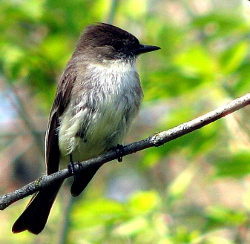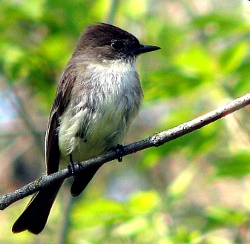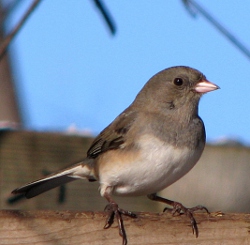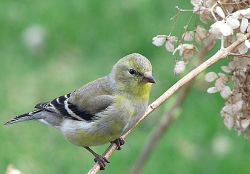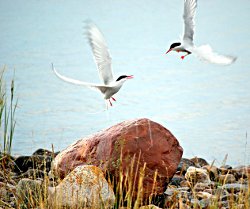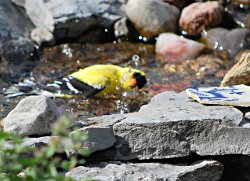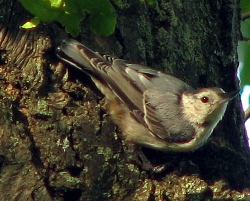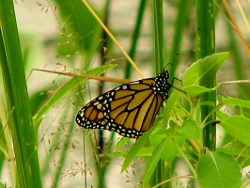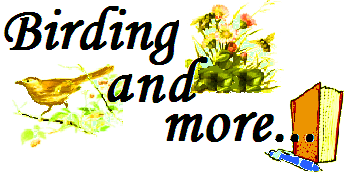 Newsletter
Newsletter
2010
/ Issue 13
IN THIS ISSUE: HOW TO PHOTOGRAPH WILD BIRDS - Part 5
In this instalment, I'll be discussing EFFECTIVE USE OF LIGHT AND BACKGROUND
Catch lights:
The reflection of light in a subject's eye is called a 'catch light'.
This is a very important element in bird photography. The catch light
adds a certain spark of life. Without it, a perched bird tends to look
like something from a taxidermist's shop window.
Here's a side-by-side example:
Blow-out: Everyone loves a bright sunny day, but
sometimes too much light results in a loss of detail called 'blow-out'.
When the white feathers of a bird are over exposed (usually due to
strong direct light) the feather detail disappears and we are left with
blank white areas. Try to avoid harsh, high contrast situations, but if
strong light is unavoidable, adjust your exposure for those bright white
spots. Here are a couple of shots that illustrate the effect. The one on
the left has a lot of blow-out, but the image on the right is properly
exposed and retains the details in the white feathers.
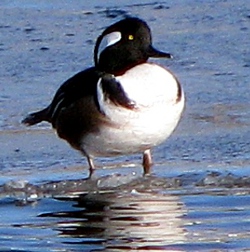
Going for Bokeh: When viewing a photograph, the eye is naturally
drawn to objects that are in focus. So ideally, in the case of bird
photography, you want the bird to be in focus and you want
everything else to be a blur. A background that is nothing but blurry
circles of indistinct objects is called 'bokeh'. Good bokeh will produce
the illusion of depth, and make your bird look even sharper. Here's an
example:
Well that's it for my series on how to photograph birds. I hope you
enjoyed it, and I hope you found it useful. If you have any questions,
don't hesitate to drop me a line at
garry@birdingandmore.com
THE READERS' PATCH
ARCTIC TERNS
In this issue, we're
featuring the photography of Bob McPherson. He was kind enough to send
us a number of remarkable photos. The one above is from his recent trip
to Great Bear Lake. The other (which is a personal favourite of mine) is
an action shot of a Goldfinch taking a dip in Bob's pond.
BATH TIME
***********************
The Readers
Patch is
a space for your photos, stories, and/or comments.
Send anything
you'd like to share with us to: newsletter@birdingandmore.com
***********************
Here are a couple of more photos from our recent vacation.
The Fall migration is underway!
.
As the temperatures start to drop, the birds start to move. It's a
great time to get out and see some fresh faces. Prince Edward Point has
already recorded 113 species, including: Swainson's Thrushes, Red-Eyed
Vireos, Belted Kingfishers, Pileated Woodpeckers, Sharp-shinned Hawks,
Broad-winged Hawks, and a variety of Warblers. Click on this link for
directions:
Prince Edward Point
New photos have been added to the following galleries:
Daylilies
Squirrels
FUN FACTS ABOUT BIRDS
.
 How
do birds stay cool?
How
do birds stay cool?
One way is to pant
(like a dog)!
Panting is like sweating
in humans. It's a bird's way of expending heat.
A bird's body temperature is higher than human's, but when they need
relief, they will pant.
It seems like the flowering has finished sooner than usual this year but maybe that's because the season started so early. At least we got to enjoy the spring earlier and maybe we'll be able to enjoy the fine weather for several more weeks!
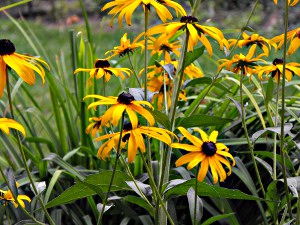
We feel a great deal of satisfaction when we look at our garden – it's come a long way over just three summers – and I don't think there's too much we still want to add. I haven't really made my choices based
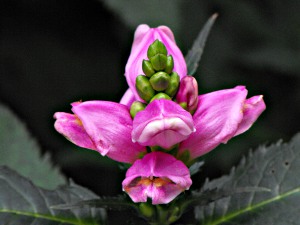 on “colours for all seasons” though, so maybe next year I do need to
plant a few
perennials that will carry on into the fall.
on “colours for all seasons” though, so maybe next year I do need to
plant a few
perennials that will carry on into the fall.
At the moment
we have Black-eyed Susans and Turtleheads adding a splash of vibrant
colour here and there and, while I'm not partial to mums and marigolds,
maybe I can still have fun looking for a
few new plants to fill that void.
If you liked our newsletter
please pass it along to your friends and family.
Subscriptions are free! Just send an
email to: newsletter@birdingandmore.com
Copyright © 2010 Garry Kirsch www.birdingandmore.com
If you wish to cancel your subscription send an email to unsubscribe@birdingandmore.com
